Dr. Patrick Gruber, CEO of Gevo, Inc., testified on the topics of Energy and Renewable Energy. His testimony put several salient facts before the Committee on Agriculture for the 2022 Review of the Farm Bill.
Overview
Dr. Gruber testified that, according to the EPA, roughly 75 percent of greenhouse gas emissions come from fossil fuels used for transportation, electricity production, and industry. Roughly 10 percent comes from agriculture. We need to reduce greenhouse gas (GHG) emissions across the board, especially by eliminating the fossil energy it’s the biggest contributor to GHG footprint.
Dr. Gruber told the committee we need to do two things to make net-zero fuels and chemicals: First we need to replace the fossil carbon with renewable carbon, and, second, to replace the fossil-based energy with renewable energy in the production processes.
A key point in Dr. Gruber’s testimony was that Gevo intends to set up a business system that financially rewards farmers for using more sustainable ag practices. We think farmers should be paid for the corn and be rewarding for making sustainability improvements. It’s a win all the way around for farmers, us, our customers, and the planet.
The Argonne GREET model is the foundation for this entire model. There are lots of carbon accounting models in use or proposed around the world, and all are based in whole or part on GREET. GREET is the foundation. The gold standard. It has the most current scientific data, it’s the most complete model.
Transcript of Dr. Pat Gruber’s testimony
Thank you, Chairman Scott, and Ranking Member Thompson, and all the Members of this Committee for the opportunity to provide testimony about renewable energy. I am honored to share Gevo’s perspective.
I am here to talk about renewable resource-based fuels, chemicals, and plastics made possible in part by climate-smart agricultural practices and access to renewable electricity and gas. Gevo’s primary emphasis is sustainable aviation fuel because of the market demand. We have the ability and technology to produce net-zero footprint fuels that are expected to help lower greenhouse gas emissions. Technologies have advanced: From renewable carbon, it is now possible to make drop-in gasoline, diesel, and jet fuels, as well as many plastics and synthetic fibers. If the fossil raw materials are replaced with renewable carbon, and the energy used for production is renewable, then it is possible to eliminate the fossil-based footprint from the products even accounting for the whole life cycle from carbon capture, through production, and ultimate burning.
Whenever we are trying to solve problems, it is always good to start with fundamental data. This chart from the US EPA (Environmental Protection Agency) shows US greenhouse gas emissions.
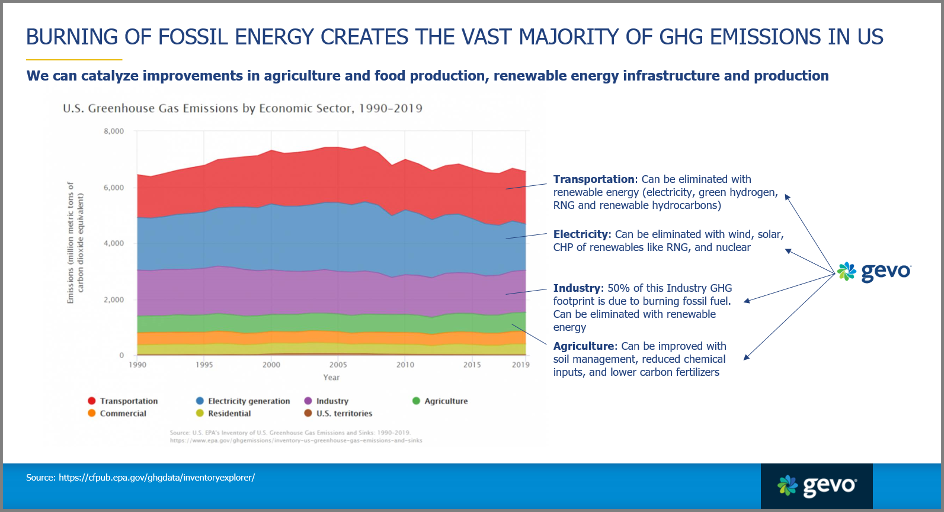
In the U.S., roughly 75% of greenhouse gas emissions come from fossil fuels used in transportation, electricity production, and industry. Roughly 10% comes from agriculture, which includes land-use changes, energy used in production of crops, and emissions from animals. The big problem is fossil-based energy in all its forms. We need to replace it. Since we need renewable carbon for making Sustainable Aviation Fuel (SAF), chemicals, plastics, and other hydrocarbon fuels and photosynthesis is the most cost-effective way to capture renewable carbon. We must pay close attention to what is done in agriculture. There is a fundamental belief that we have: When using agricultural land, priority must always be on food first. Always. When talking about food, it is nutrition that is most important. Nutrition is about protein. Land should be used to produce protein. Using corn as a feedstock, large quantities of protein and carbohydrates are produced as well as some oil. Protein and oil need to go to the food chain, carbohydrates, that have little to no nutritional value, make sense to use as feedstocks for fuels, chemicals, and plastics.
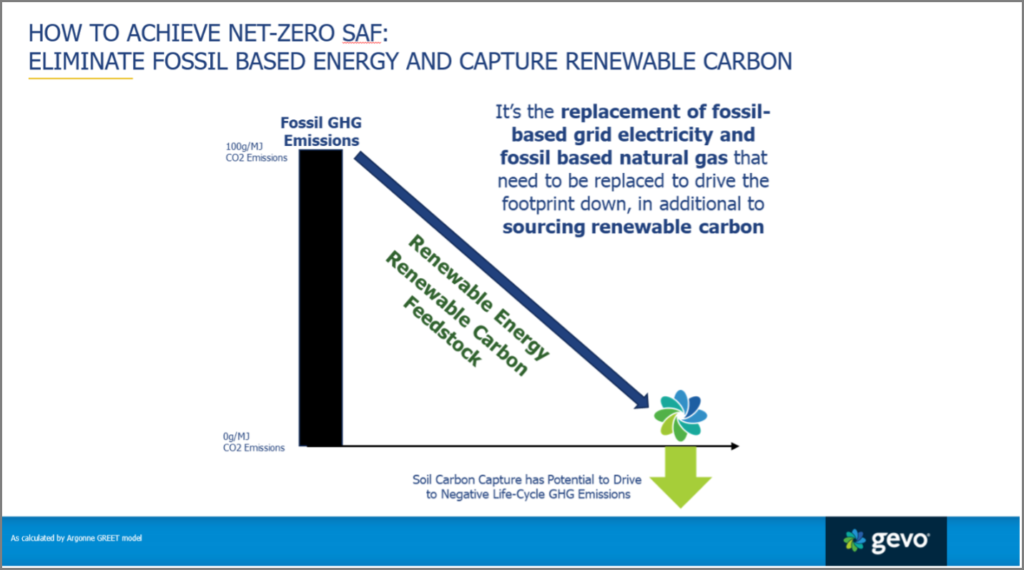
To drive SAF to a net-zero carbon footprint we need two things: sustainably produced renewable carbon, and renewable energy for the production processes. We believe the entire lifecycle must be accounted for, audited, and reported—from field to combustion. This means capturing data at the field level, being specific about the agricultural practices used in production of crops, being specific about land-use changes, about changes to soil carbon, about the sources of energy used in manufacturing. Collecting and reporting factual data is what enables proper decision making. In the industry, we talk about fossil-based GHG reductions as Carbon Intensity Score reductions or simply CI for short.
A real example can make this all more concrete: We’ve been developing the concept of a Net-Zero manufacturing plant for SAF. A Net-Zero plant is one that can produce net-zero GHG footprint products. We call the first plant Net-Zero 1 or NZ1. NZ1 is planned to be built in Lake Preston, South Dakota, a town of 700 or so people. We’ve already proven that the technologies work; we are in the middle of engineering it. We expect it to be operational in 2025. The total installed, financed cost is currently projected to be about $900 million dollars. (I suspect we are about to dramatically improve the lives of the people in and around Lake Preston). NZ1 currently is planned to take in 35 million bushels of climate-smart corn (produced with low-till or no-till technologies), separate the protein and oil sending it to the food chain, and using the carbohydrate to feed a fermentation to produce an intermediate ethanol feed which then goes into the hydrocarbon chemical plant to make the fuel.
We expect to produce about 430 million pounds of protein products for animal feed and the food industry, about 30 million pounds of corn oil, and 60 million gallons per year of hydrocarbon fuels products, with the vast majority being SAF. NZ1 is being designed to be “off the grid.” We don’t want to use grid electricity, it’s too dirty, nor do we want to use natural gas for the same reason. NZ1 will have what we call an “energy complex” as part of the project. This would include a 60-megawatt wind farm, and our own water-treatment plant that produces enough biogas to offset the need for fossil-based natural gas. We also plan to produce green hydrogen with excess wind capacity. The investment in renewable energy is in the range of another couple hundred million dollars, and currently is planned to be deployed by partners. It’s the integration of the energy complex into the production processes, optimizing the entire system for driving the CI score down that enables a net-zero end product.
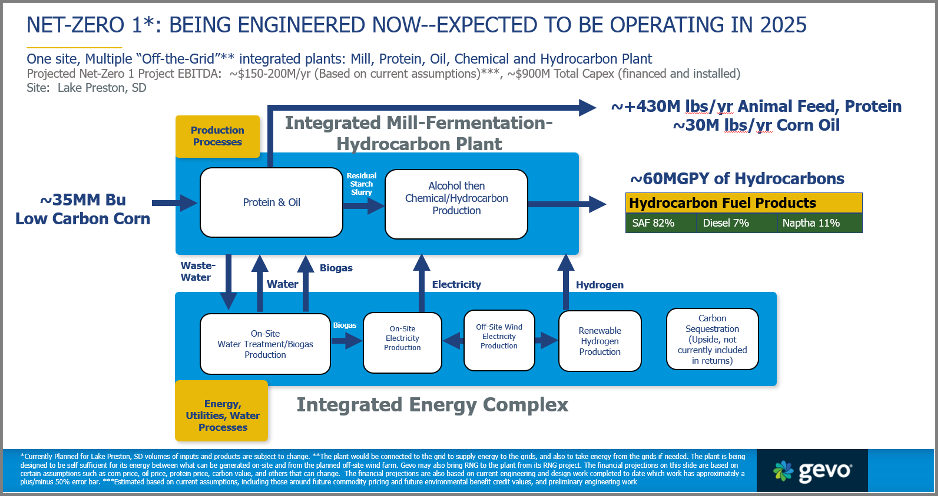
So how do we measure GHGs and improvements? We use the Argonne GREET model. It is the most scientific and vetted model. It is the basis for all models used around the world today to count carbon through the full lifecycle. Using this GREET model, this is what the greenhouse gas emissions look like for our products produced at an NZ plant.
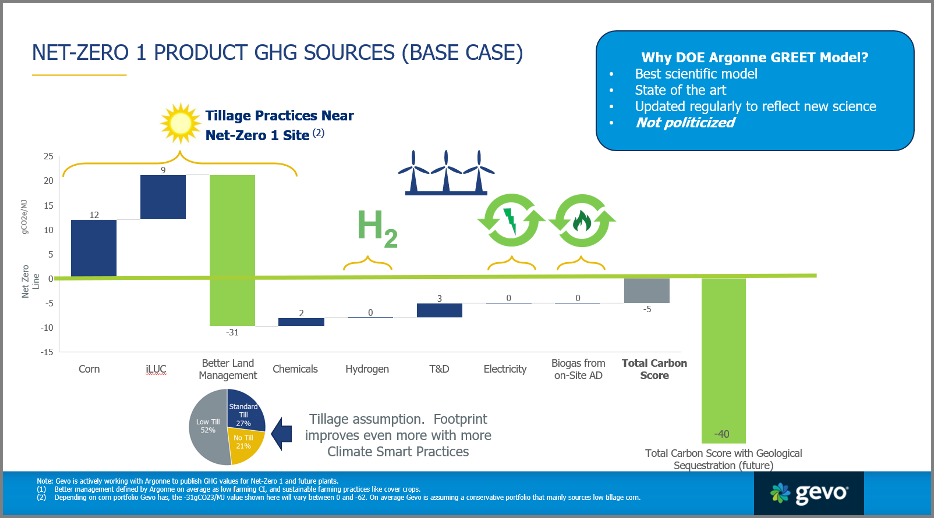
The calculation includes land use, climate-smart ag practices for growing corn, and renewable resource-based energy inputs allowing our NZ1 total carbon intensity score to be reduced to approximately negative 5. It is possible to drive the footprint even lower: our business system could capture more carbon in the soil, or we could capture the CO2 emissions from the plant and geologically sequester them. If we were to use geological sequestration, then the CI score would drop further, potentially to negative 40. Keep in mind this is after it’s been burned as jet fuel. The SAF in a tank at our plant would be negative 90 or more CI score.
It is literally renewable energy in a tank and can readily be transported with existing infrastructure. The renewable energy can be used for engines as discussed so far, or even be used to feed generators to produce low GHG electricity. We also plan to make chemicals that go into plastics and durable goods. Using a NZ business system, the CI score of chemicals we could supply would be expected to be strongly carbon negative, so long as they aren’t burned at the end of their life. We plan to sell primarily jet fuel, some gasoline and diesel fuel because these products have clear value in the marketplace. Chemical products and materials markets generally aren’t valued for CI score reductions yet.

For the sake of our land, food production, and carbon reduction: Agricultural practices are incredibly important to get right. Right now, only 50% of the cropland uses no till or low till practices. According to Purdue University, if everyone used low till or no till, we’d could save about 2% of the total greenhouse gas emissions of the United States—just through agricultural alone. With more advanced techniques, it could be possible to capture even more carbon in the soil. We intend to set up a system that rewards farmers for using climate-smart agricultural practices. Low-till and no-till allow the root systems of crops to remain intact and that means nutrients stay in the soil, water is retained, and it takes less chemicals per unit of product produced. It’s a win all the way around for farmers who can make more money by producing and selling products that provide food, fiber, and sequester carbon simultaneously. Programs should be designed to recognize and reward these practices through the value chain.
Given the yield improvements in corn we don’t see a need to increase the amount of land used for farming. Consider that with the projected yield improvements in corn by 2040, approximately 5 billion gallons of SAF could be produced, along with about 35 billion lbs of protein for the food chain with no land use change. If we decarbonized existing ethanol plants with renewable energy and our NZ concepts, then that ethanol capacity could at least in part be converted to SAF production, giving a market to ethanol amid a long-run shrinking gasoline market.
Because carbon accounting is critical to success, we must have accurate, fact-based measurements of carbon throughout the whole life cycle. The GREET model is the go-to standard. It has the most current scientific data, it’s the most complete with the most up to date data. I congratulate the USDA and the DOE for collaborating effectively in putting the agriculture data into GREET.
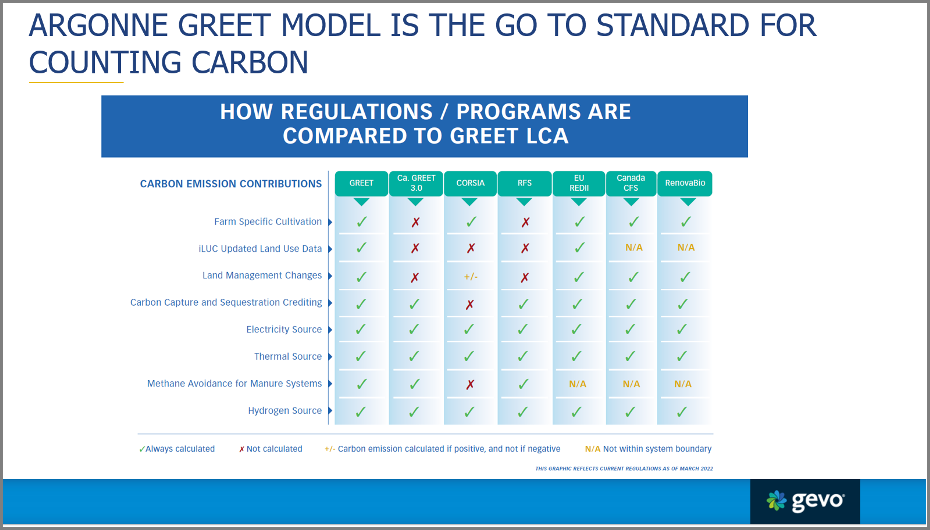
On this chart you see a variety of models for counting carbon. All of these are based on the GREET model as a starting point. EU REDII is the standard European model for measuring carbon and it follows the GREET model through the full lifecycle. The California model uses GREET, but they simplify the agricultural segment by using averages for corn and soybeans, not considering climate-smart ag practices, at this point. They would need to see specific data to make a change, I think. CORSIA is interesting in that it’s a newer international model that doesn’t allow for sequestration nor does it incentivize or account for better land management practices or better agricultural practices. It appears to be a biased model in my opinion, at least in these areas. As policy is developed, we would like to see the GREET model be the standard for domestic carbon accounting. Updated facts and science are what the GREET model uses and is the reason so many rely on it.
The USDA has done a terrific job of helping to improve agriculture and rural economies over the last 30 years of my career, I wish that people could better understand this. The USDA is right on track with programs that promote climate-smart agricultural practices, counting carbon, and re-powering our rural communities, especially enabling access to renewable energy.
To facilitate wider adoption of these practices, farmers need to have access to advanced equipment to help them lower their footprint, in addition re-instating the Rural Re-Powering Program is critical to producing net zero hydrocarbons and in making carbon negative chemicals and materials for durable goods. Continued research at universities focused on soil science, how to improve agriculture, and measure more accurately what is happening at the field level, will help farmers adopt practices to improve their footprint. New net-zero products require the deployment of new capital and any programs that help defray the cost of that capital are welcome, so long as they are feedstock neutral, technology neutral and stand on merit.
We appreciate the work that the USDA and the DOE have done on GREET. Going forward we think it is important for additional harmonization of models and data for counting carbon. We’d like to see program funding for measuring carbon to build out a National CI calculator, and more comprehensive systems for field to fuel tank accounting. These programs will harness the might of the U.S. agricultural system to positively impact climate change, sustainability of agriculture, energy security, and our food supply.
Watch Video of Dr. Patrick Gruber’s Testimony
Dr. Gruber’s testimony before the House Agriculture Committee begins at 3:20:14
